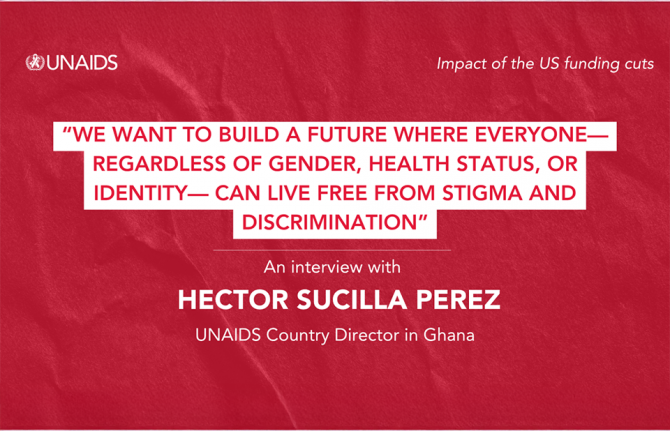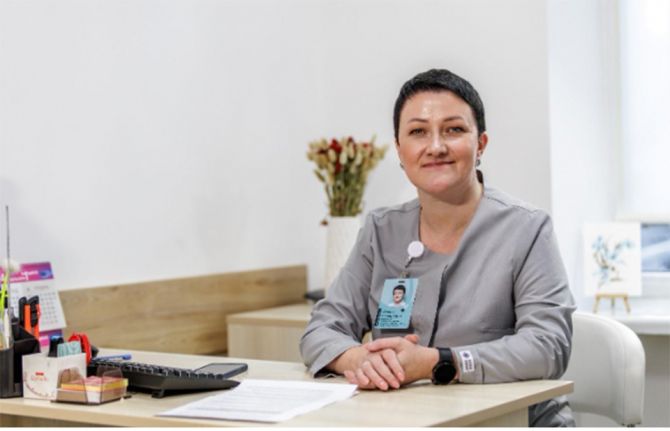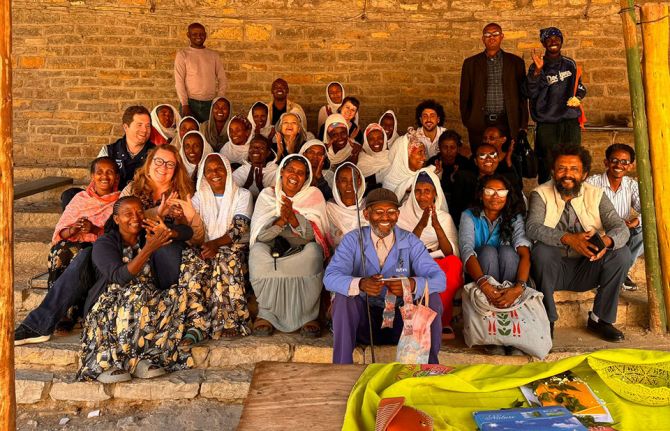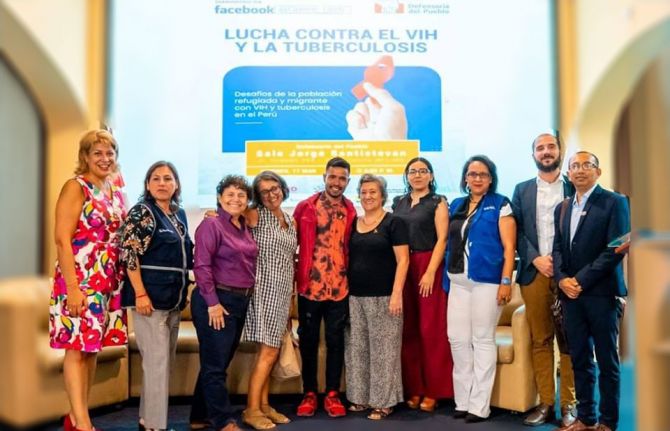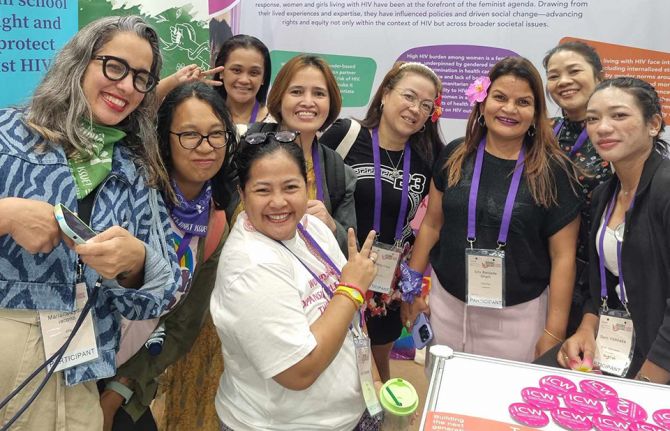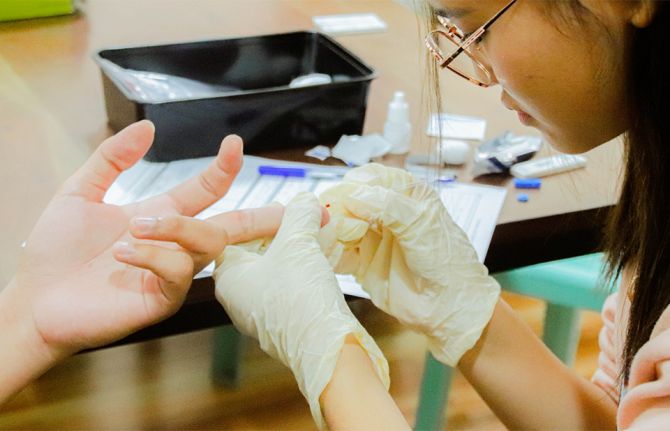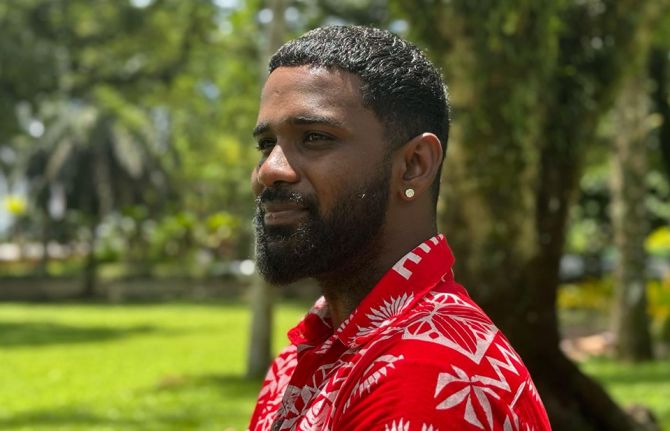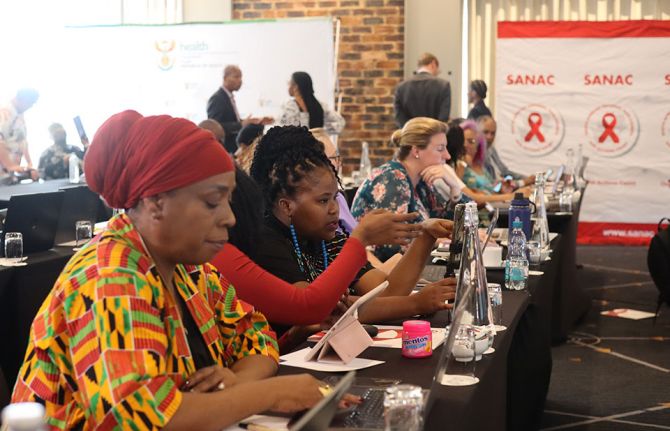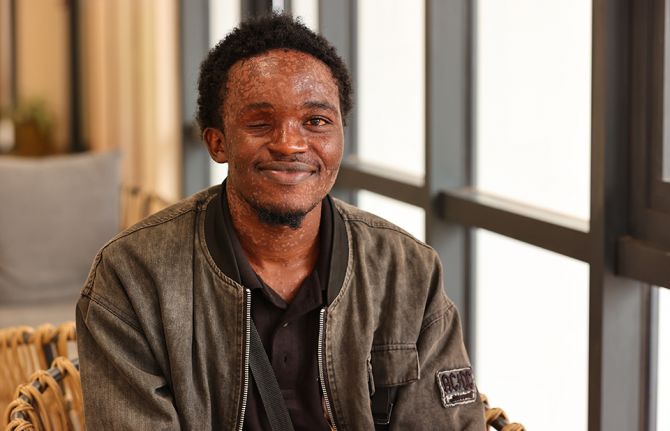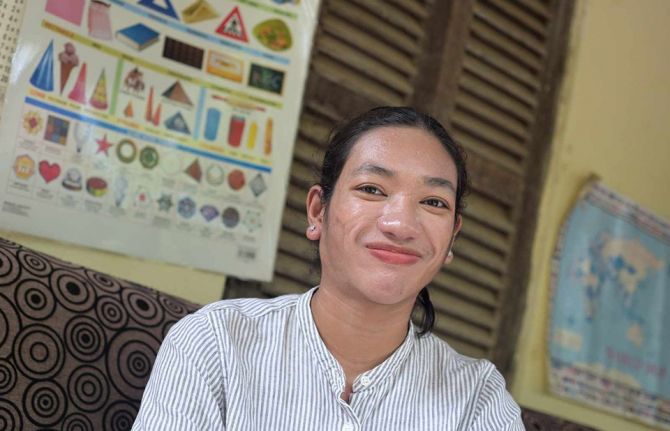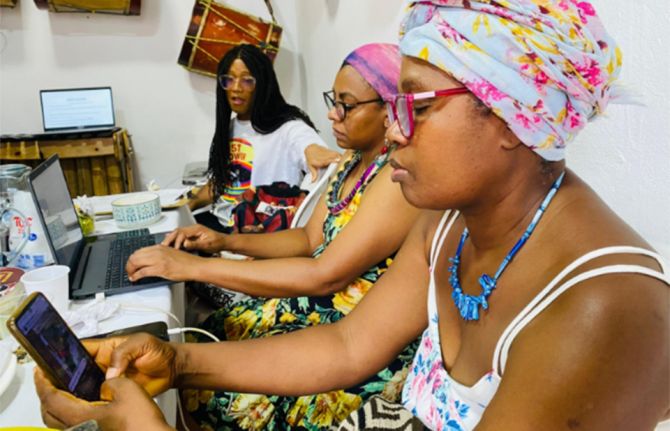
Feature Story
UNAIDS mission highlights HIV response among female sex workers
24 January 2011
24 January 2011 24 January 2011
Ms Jan Beagle, Deputy Executive Director of UNAIDS with H.E the Vice President and Chair of the Ghana AIDS Commission Mr John Dramani Mahama. Credit: UNAIDS
About 2% of the adult population in Ghana is living with HIV—a figure that has remained unchanged for the past 10 years. The number of new HIV infections in this West African nation, estimated at about 22 000 per year, has also stabilized over the past decade.
Despite a relatively stable HIV prevalence in the country, several populations appear to be at high risk of HIV, including female sex workers and men who have sex with men. According to a recent survey, HIV prevalence among sex workers in Accra and Kumasi was 25% in 2009. Sex work in Ghana also contributes to a significant proportion of new HIV infections.
In an official mission to Ghana, Jan Beagle, UNAIDS Deputy Executive Director (Management and External Relations), met with a group of female sex workers at the Accra headquarters of the West African Program to Combat AIDS and STI (WAPCAS), a non-government organization that develops and implements HIV programmes for female sex workers, their clients and men who have sex with men.
With 20 satellite offices nationwide, the organization provides a range of services, including reproductive health education, condom promotion, HIV counselling and testing, and clinical services such as the management of sexually transmitted infections. WAPCAS is also working closely with UNAIDS, UNFPA and local police to address discrimination and human rights abuses against sex workers.
All forms of discrimination against key affected populations, such as sex workers, block access to HIV services and impact the quality of care for people living with HIV
Jan Beagle, Deputy Executive Director of UNAIDS
“I can’t stop sex work because I have five children that I am taking care of by myself,” said one female sex worker, during the visit with Ms Beagle. “Engaging in sex work is the only way I can provide for my family since I don’t have any employable skills,” she added. Other sex workers told the Deputy Executive Director that they were unable to report human rights abuses to police because their work is considered illegal in Ghana.
Ms Beagle said that UNAIDS is serious about focusing HIV resources and attention on sex workers, as they form one of the most important populations at higher risk of HIV infection in Ghana. “All forms of discrimination against key affected populations, such as sex workers, block access to HIV services and impact the quality of care for people living with HIV. We must do more to address stigma and discrimination in Ghana.”
During her mission, Mr Beagle met with Mr John Dramani Mahama, Vice President of the Republic of Ghana. Ms Beagle congratulated Ghanaian authorities on the political and financial commitment they have shown in the national AIDS response, while underscoring the urgent need to prioritize HIV resources for populations at higher risk of HIV infection.
Mr Mahama reiterated his Government’s commitment at the highest level to “vigorously combat” the HIV epidemic in Ghana. He pledged to provide the necessary resources to eliminate mother-to-child transmission of HIV and reduce stigma and discrimination against key affected populations.
Related
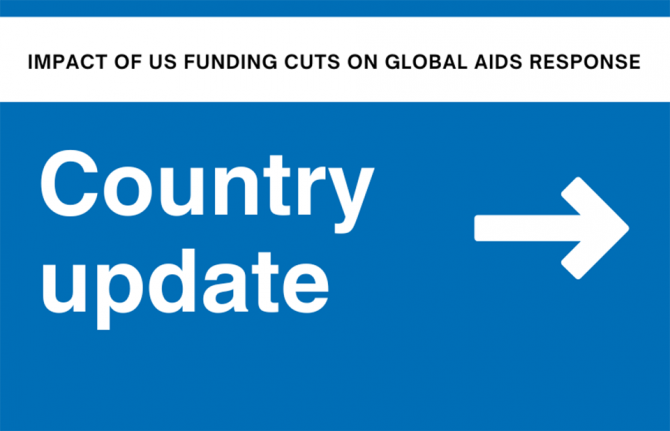 Impact of US funding cuts on HIV programmes in Ghana
Impact of US funding cuts on HIV programmes in Ghana

08 April 2025

Feature Story
Young people in Tajikistan help each other prevent the spread of HIV
12 January 2011
12 January 2011 12 January 2011A version of this story was first published at www.unfpa.org

Tajikistan youth in a Y-PEER skills building training session.
Credit: UNFPA
Twenty-year-old Khairi Kamolova is among a growing group of young people in Tajikistan dedicated to making a difference in the national challenge to HIV. Prevalence in this central Asian country has increased from 0.1% in 2001 to 0.2% in 2009 and more than 9,000 people are estimated to be living with the virus.
The major factors facilitating HIV’s spread include injecting drug use, high levels of stigma and discrimination and poor knowledge of how HIV is transmitted. Eastern Europe and Central Asia are the only areas where AIDS-related deaths have continued to rise, according to the latest UNAIDS global report.
Ms Kamolova is part of the Y-PEER (Youth Peer Education Network) programme, spearheaded by UNFPA, which was launched several years ago in Tajikistan to improve the quality of peer education in the country and to enable young people to successfully reach out to youth in their own communities, especially in rural areas.
In 2008 she attended a National Y-PEER Training of Trainers event and since then has actively supported the network, sharing information on HIV prevention and being on hand to give practical help, support and advice to rural youth and their families.
During her work she has faced a variety of challenges, including misunderstandings among her fellow villagers, but she says she is sustained by her belief that helping save even one life is an important contribution to the AIDS response.
With some 30% of Tajikistan’s population under the age of 25 and more than 70% living in the countryside, reaching rural youth with HIV prevention messages is vitally important. This knowledge prompted UNFPA, UNDP and the Global Fund to fight AIDS, Tuberculosis and Malaria to support a two-year Y-PEER project on HIV prevention among such youth in 2008. More than 300 volunteers and coordinators of the Committee of Youth Affairs (CYA) were trained in the use of peer education and theatre techniques.
During 2009-2010 coordinators and volunteers of the CYA participated in Y-PEER training of trainers and jointly conducted more than 1200 seminars and training sessions in rural areas of Tajikistan on healthy lifestyles, including HIV prevention. They reached some 21, 000 young people, of which more than 44% were young women. According to pre and post training questionnaires, some 80% of participants in the intervention gained new knowledge and skills.
Started in Eastern Europe, Y-PEER now has international scope, connecting over 7000 peer educators with information, training, support and a wide range of electronic resources.
Related

Feature Story
HIV and conflict: Connections and the need for universal access
27 October 2010
27 October 2010 27 October 2010A Forced Migration Review special supplement

Kibati camp for displaced people, DRC. Credit: Christian Als
The interconnections between conflict and HIV are complex. HIV affects the lives of many people caught up in conflict, including the civilian population but also the protagonists, as well as those whose role it is to provide security during and after conflict.
In conflict, people may be subjected to mass displacement and human rights abuses, including sexual violence, or left in conditions of poverty and powerlessness that might force some individuals to sell sex to survive. In addition, infrastructure may be damaged, and prevention and health services disrupted. Such conditions put populations at increased risk of HIV infection, and women and children are especially vulnerable.
A special supplement on HIV has been published by the journal Forced Migration Review, with support from UNAIDS. This edition is largely based on the work of the AIDS, Security and Conflict Initiative (ASCI), which undertook research over a number of years to gather evidence and advance analysis on the connections between HIV and conflict.
Specially tailored programmes to ensure universal access to vulnerable groups must become an integral part of national HIV policies and strategies, and a key item on the agenda of the international community, according to the article by UNAIDS.
The analysis addresses how to achieve greater and better access to HIV prevention, treatment, care and support for people during and after conflict. It concludes that it is unlikely that Millennium Development Goal 6 will be met without HIV services reaching displaced populations and migrants, regardless of their HIV status, as well as the uniformed services that interact with these populations.
The supplement presents a selection of the ASCI case-studies alongside a number of articles on the subject which were submitted in response to a Forced Migration Review call for articles. UNAIDS and its cosponsors UNFPA and UNHCR as well as various research partners contributed articles. In addition, Dr Nafis Sadik, Special Envoy of the UN Secretary General for HIV/AIDS in Asia and the Pacific authored a piece on the linkages between forced migration and HIV in Asia.
Download the full publication here

Feature Story
Emerging from conflict: women’s role in rebuilding better, fairer communities
20 October 2010
20 October 2010 20 October 2010
Women clearing rubble from the streets of Port-au-Prince, Haiti. Credit: UN Photo/Sophia Paris
Too often women suffer the worst consequences of war. In certain parts of the world gender-based and sexual violence are increasingly used as a weapon of conflict and are a prevalent characteristic of numerous humanitarian crises. The latest flagship report from the United Nations Population Fund (UNFPA), State of world population 2010, explores the dangerous consequences for women caught in conflict and crisis who are left vulnerable to HIV infection, disabilities, social stigma and psychological trauma.
The publication of the report, which also highlights many positive actions by individuals, civil society and governments to confront this issue, coincides with the tenth anniversary of Resolution 1325 on Women, Peace and Security. The resolution is the United Nation’s Security Council’s challenge to the abuse of women in conflict and their marginalisation in the peace building process.
Subtitled From conflict and crisis to renewal: generations of change, the report examines developments in the 10 years since this key resolution. The report is based on stories from the field in a range of countries that have experienced turmoil and are now on the sometimes rocky road to recovery: Bosnia and Herzegovina, Liberia, Timor-Leste and Uganda.
HIV in crisis situations
The impact of HIV in crisis situations is also explored. Sexual violence makes women vulnerable to HIV infection. The social instability, poverty and powerlessness that often accompany social upheaval and displacement also facilitates HIV transmission with weakening of norms regulating sexual behaviour.
Countries should not just be rebuilt, but built back better and renewed, with women and men on equal footing, with rights and opportunities for all.
Thoraya Ahmed Obaid, UNFPA’s Executive Director
The report shows how women and young people have overcome difficulties and started to rebuild their lives and their communities. In post-conflict northern Uganda, where a rebel war raged for more than 20 years, young people are working with the local branch of Straight Talk Foundation, a national NGO, which has set up the Gulu Youth Centre. It is now a major provider of sexual and reproductive health care for youth in the area, including HIV counselling and testing. This is a much-needed service for the region's young women as older teenage girls are much more likely to be living with HIV.
Women and men together for peace
There is also recognition that men play a vital role in bringing about positive change. Male traditional leaders in Africa and the Asia-Pacific region are now taking women’s rights and needs into account in decision-making.
Increasingly, women are also elected as local leaders on their own steam and take active part in re-building society in post-conflict situations. For example in Burundi and Nepal, two conflict affected countries, women in civil society have been heralded for their efforts and impact throughout the peace process.
According to the State of world population, concerned people at all levels are searching for ways to build new and healthy societies where women and girls—and men and boys—can flourish.
As Thoraya Ahmed Obaid, UNFPA’s Executive Director, said about the report, “Countries should not just be rebuilt, but built back better and renewed, with women and men on equal footing, with rights and opportunities for all.”

Feature Story
Asia-Pacific drive for increased focus on HIV and sex work
20 October 2010
20 October 2010 20 October 2010
Sex workers, government officials and UN representatives joined the first-ever Asia-Pacific regional consultation on HIV and sex work. Credit: APNSW
HIV transmission via sex work accounts for many new HIV infections in the Asia-Pacific region. Yet in many countries HIV prevention, treatment and care services for sex workers are lacking. At the first consultation of its kind in the region, sex workers, government officials and United Nations participants emphasized the urgent need for action to increase focus on sex work within national HIV responses.
“I was arrested when the police saw I had condoms.” “Sex workers’ rights are being violated.” “Sex workers are going underground now. We don’t know where they are.”
These are just some of the experiences shared at the first-ever Asia-Pacific consultation on HIV and sex work, held in Pattaya, Thailand, from 12-15 October. Some 150 participants from eight countries* in the region—including sex workers, government officials, representatives from civil society and the United Nations—came together to call for a greater emphasis on ensuring universal access to HIV prevention, treatment, care and support services for sex workers.
Sex workers experience firsthand the effects of laws and harmful enforcement practices that violate their human rights and hamper progress in the HIV response.
Jan Beagle, UNAIDS Deputy-Executive Director, Management and External Relations
Hosted by the Royal Government of Thailand and co-organized by UNAIDS and UNFPA, in collaboration with the Asia-Pacific Network of Sex Workers (APNSW), meeting participants shared strategies and developed national action plans to be carried forward.
Sex work accounts for a significant number of new HIV infections in the Asia–Pacific region. An estimated 10 million Asian women sell sex to 75 million men who, in turn, have intimate relations with an additional 50 million people. In some countries in the region, HIV prevalence among sex workers is nearly 20%. Meet participants stressed that spending on HIV services is falling, despite evidence of their cost-effective impact and that only about one third of sex workers in the region are able to access HIV prevention programmes.

Khartini Slamah of APNSW moderates a discussion on legal and policy barriers. Credit: APNSW
Meeting participants also pointed to numerous punitive laws and policies that can prevent sex workers from accessing HIV services. “Sex workers experience firsthand the effects of laws and harmful enforcement practices that violate their human rights and hamper progress in the HIV response,” said Jan Beagle, UNAIDS Deputy-Executive Director, Management and External Relations, who attended the consultation. “Listening to sex workers is crucial.”
Participants in the consultation heard how sex workers are frequently subjected to violence and harassment, and often face criminal charges and detention. Participants said enforcement of elements within new anti-trafficking and other related laws in some countries including Cambodia, Fiji and Thailand had exacerbated this situation, citing recent cases where carrying condoms had led to arrests.
“Every day we confront brutal realities—arrest, violence, discrimination,” said Kay Thi Win, Chair of APNSW and programme manager of a successful and long-running outreach programme in Myanmar that is largely run by sex workers or former sex workers. “We want to turn the tide by demanding that initiatives designed ‘for’ us be designed ‘with’ us,” she said.
*Cambodia, China, Fiji, Indonesia, Myanmar, Pakistan, Papua New Guinea and Thailand

Feature Story
More than a game: using football to promote health issues in Uganda
30 September 2010
30 September 2010 30 September 2010A version of this story first appeared at www.unfpa.org

The UNFPA-sponsored football tournament offered a way to get the attention of young people in northern Uganda. Photo: Stijn Aelbers/UNFPA Uganda
Although hostilities in northern Uganda ceased in 2006, the lives of young people, formerly targets for abduction by the Lord’s Resistance Army, have not been easy. During the conflict, which lasted more than 20 years, many children spent their early years confined to camps for displaced persons, while others were subjected to trauma, brutality and suffering as child soldiers.
Prolonged instability also took a toll on health and social support systems: reproductive health indicators in the sub-region are among the lowest in the country, and gender-based violence is common.
While the majority of youth—who comprise 56 % of Uganda’s population—live in poverty with few educational or employment opportunities, football is one thing that they can get excited about and that allows them to forget about their troubles. Florence, age 23, from a squad in Gulu District said, “If we come to play football we forget our problems at home. It is like stress management.”
At the Acholi Football Tournament, which took place in five districts, and was supported by UNFPA, the United Nations Population Fund, the goal was to do more than more than help young people relax. It also aimed to reduce teenage pregnancy and gender-based violence, two of the most serious problems in the area.
Referees, coaches, and team captains attended training sessions on the issues, and then became a resource for information, discussion, and guidance. Subsequent dialogue sessions reached some 1,200 players.
Top local officials awarded the winning teams with uniforms that read, “Say no to GBV (gender-based violence) and teenage pregnancy.” Health care workers were also on hand to answer questions and provide health counseling. Over the course of two days, some 10,000 condoms, most supplied by UNFPA, were distributed by health workers and peer counsellors as well as representatives of the Boda Boda Association, which employs many young men as motorcycle taxis drivers.
More than 800 individuals, mostly young men, took advantage of the free voluntary testing and counselling that was offered to allow them to check their HIV status.
Women were also on the pitch, although many are less experienced than their male counterparts, spectators say the buzz of the women’s matches created were a demonstration of the growing popularity and re-thinking of gender roles
A player from the Lalogi team said she has encountered negative attitudes. (See how these are addressed in a new electronic football game.) However, 21-year-old Rose said her husband was supportive: “He is happy that I play. I think he is here watching today,” she shouted over her shoulder as she ran onto the pitch for kick-off.

Feature Story
Maternal deaths worldwide drop by a third
15 September 2010
15 September 2010 15 September 2010
The number of women dying due to complications during pregnancy and childbirth has decreased by 34% from an estimated 546 000 in 1990 to 358 000 in 2008, according to a new report, Trends in maternal mortality, released by the World Health Organization (WHO), the United Nations Children's Fund (UNICEF), the United Nations Population Fund (UNFPA) and the World Bank.
Despite this notable progress, the annual rate of decline is less than half of what is needed to achieve the Millennium Development Goal (MDG) target of reducing the maternal mortality ratio (the number of deaths per 100,000 live births) by 75% between 1990 and 2015. This will require an annual decline of 5.5%: the current average annual decline of just 2.3%.
"The global reduction in maternal death rates is encouraging news," says Dr Margaret Chan, the Director-General of WHO.”No woman should die due to inadequate access to family planning and to pregnancy and delivery care."
For nations with high HIV prevalence, AIDS has become a leading cause of death during pregnancy and after the birth. There is also some evidence that women living with HIV are at greater risk of maternal death. Overall, it was estimated that there were 42 000 deaths due to AIDS among pregnant women globally in 2008. About half of those are estimated to be maternal. The contribution of HIV was highest in sub-Saharan Africa where 9% of all maternal deaths were AIDS-related.
“Integrating HIV services with maternal and sexual and reproductive health services is imperative to stop mothers from dying and babies from being born with HIV,” said Mr Michel Sidibé, UNAIDS Executive Director. “The AIDS movement must be leveraged to achieve reductions in maternal and child mortality.
According to the report pregnant women die from four major causes: severe bleeding after childbirth, infections, hypertensive disorders, and unsafe abortion. Every day, about 1000 women died due to these complications in 2008, more than half in sub-Saharan Africa. The risk of a woman in a low-income country dying from a pregnancy- related cause during her lifetime is about 35 times greater than a woman living in a high-income country.
"To achieve our global goal of improving maternal health and to save women's lives we need to do more to reach those who are most at risk," says Anthony Lake, Executive Director of UNICEF. "That means reaching women in rural areas and poorer households, women from ethnic minorities and indigenous groups, and women living with HIV and in conflict zones."
The new estimates show that it is possible to prevent many more women dying. Countries need to invest in their health systems and in the quality of care.
"Every birth should be safe and every pregnancy wanted,” says Thoraya Ahmed Obaid, the Executive Director of UNFPA.The lack of maternal health care violates women's rights to life, health, equality, and non-discrimination.
UN agencies, donors and other partners have increasingly coordinated their assistance to countries, focusing on those with the greatest burden.
According to Tamar Manuelyan Atinc, Vice President for Human Development at the World Bank, “Given the weak state of health systems in many countries, we must work closely with governments, aid donors and agencies, and other partners to strengthen these systems.

Feature Story
Conference underscores young people’s leadership in HIV prevention
27 August 2010
27 August 2010 27 August 2010
Over five days, delegates from 112 countries—including 25 000 youth and representatives from government, civil society and the United Nations—shared ideas on young people’s involvement in achieving the Millennium Development Goals (MDGs).
The role of young people in improving the state of the world took centre stage at this week’s World Youth Conference in Leon, Mexico. Over five days, delegates from 112 countries—including 25 000 youth and representatives from government, civil society and the United Nations—shared ideas on young people’s involvement in achieving the Millennium Development Goals (MDGs).
With an estimated 40% of new HIV infections occurring among people aged 15-24, a youth-centered approach to the AIDS response will be critical to meet MDG 6—halting and reversing the spread of HIV—and to ensure efforts are sustained in the long term.
In a video message to young delegates, UNAIDS Executive Director Michel Sidibé said that young people had the power to shape a future with zero new infections, zero discrimination and zero AIDS-related deaths. “Each of you is a driving force for change and development in your own countries,” he said. “Together you are an incredible movement that is shaping the future of the world.”
Of the 33.4 million people living with HIV worldwide, some 5 million are young people. An estimated 2500 young people become newly infected with HIV each day. The epidemic has taken a particularly devastating toll on the lives of young women, who account for 66% of infections among youth worldwide.
Empowering young people to protect themselves from HIV represents one of UNAIDS’ ten priority areas, with the overall goal of a 30% reduction in new HIV infections by 2015.
At a joint workshop on HIV and young people, UNAIDS and UNFPA introduced a new “business case” outlining successes to date in the HIV response among youth and areas for improvement. Through the workshop, young delegates were invited to offer their perspectives on the relevance and application of the business case at the national level. Evidence-based information and HIV services, including sexual and reproductive health, were highlighted as critical to reducing infection among young people. Many participants voiced concern over reaching young people with effective HIV prevention messages.
“As we are still young and exploring, we may get into risky behaviors,” said Rodriguez Gastelum, a youth participant from Mexico who attended the workshop. “Correct information on HIV is the first step—that will protect us.”
Less than 40% of young men and women have access to accurate knowledge about HIV transmission—far short of the 95% target set in the UNGASS Declaration of Commitment for the year 2010. In developing countries, excluding China, only 30% of young men and 19% of young women benefit from comprehensive information on HIV.
Despite challenges, there are signs of progress. A new study from UNAIDS has reported a more than 25% drop in HIV prevalence among young people in 15 countries heavily affected by the AIDS epidemic.
“Simply put, young people are leading a prevention revolution all over the globe,” said Dr. César Nunez, Director of the UNAIDS Regional Support Team for Latin America, in a health-focused session at the conference. “The empowerment of young people has led to changes in sexual behavior. Young people are choosing to have sex later, with fewer partners, and they are using condoms.”
Earlier this month, the UN launched the International Year of Youth, an initiative designed to increase youth participation in global development issues and enhance inter-cultural dialogue and understanding across generations. At a launch event in New York City, UN Secretary-General Ban Ki-moon urged young people across the world to look beyond the borders of their own countries: “Engage with the world. Become a global citizen,” he said. “We are the leaders of today. You are the leaders of tomorrow.”
Right Hand Content
Cosponsors:
Press centre:
Joint statement by Heads of UN entities for the launch of the International Year of Youth
Multimedia:
View UNAIDS Executive Director’s video message (You Tube)
External links:
World Youth Conference 2010
International Year of Youth
Publications:
Young people business case for the UNAIDS priority area on young people
UNAIDS Outlook supplement: ‘Young people are leading the HIV prevention revolution’
Global guidance briefs on HIV and young people
Related

Feature Story
Y-PEER: Media helping empower young people to protect themselves from HIV
22 July 2010
22 July 2010 22 July 2010
Y-PEER event at AIDS 2010, 23 July 2010. Credit: UNAIDS/Heimo Aga
Harnessing the power of the mass media and new technologies to reach young people with information about HIV and reproductive health was high on the agenda at the XVIII International AIDS conference yesterday during a series of events sponsored by Y-PEER, a youth initiative pioneered by the United Nations Population Fund (UNFPA).
According to UNFPA a youth-centred approach, such as Y-PEER, is critical to genuine engagement for change.“If we want to engage young people on health and lifestyle issues that affect them, we need to be where they are, sharing information through platforms they are connecting to every day,” said Purnima Mane, UNFPA Deputy Executive Director (Programmes).
“Run by youth for youth, Y-Peer continues to grab hold of the latest trends in entertainment and social media through innovative partnerships to promote health and prevent HIV infection.”
In an innovative session, Using Edutainment for Social and Behaviour Change, one of Hollywood’s top writers and producers, Zoanne Clack of the award-winning US series Grey’s Anatomy, joined experts, such as Colin Dixon of Dance4Life, AIDS activists and Y-PEER ambassadors to discuss how HIV is dealt with in the entertainment media.
 Y-PEER phone app launched at AIDS2010, 23 July 2010. Credit: UNAIDS/Heimo Aga
Y-PEER phone app launched at AIDS2010, 23 July 2010. Credit: UNAIDS/Heimo AgaY-PEER is partnering with the Hollywood Health Society (HHS), which was represented by its director, Sandra de Castro Buffington, during the event. HHS, based at the University of Southern California, aims to provide writers and producers with accurate information for health storylines. Y-PEER works with HHS to try to identify similar models that can be easily replicated in other regions with the aim of sensitising the film industry and to encourage featuring HIV in popular programmes.
The session explored how education-entertainment, or ‘edutainment’, can bring issues around sexual and reproductive health, sexuality and HIV alive for a young audience, and how this can contribute to them making informed decisions in this critical area, helping them better protect themselves against the virus and reducing their vulnerability. Empowering young people to protect themselves from HIV is one of the ten priority areas in the UNAIDS Outcome Framework (2009-11).
Recognising the role that celebrities can play in using their influence to highlight issues and change attitudes, beliefs and behaviour, a number of stars who are also Y-PEER ambassadors attended the session as guest speakers. These included Hollywood resident actor and activist Sammy Sheikh (who appeared in the series ‘24’, United States of Tara and LOST) and singers Daniela Dimitrovska (Macedonia), Lotfi (Tunisia) and Ana Stanic (Serbia).
Last night also saw the launch of Y-PEER knowledge applications for smart phones. Building on the Y-PEER programme, this new ‘app’ is intended to test young people’s skills and knowledge surrounding adolescent sexual and reproductive health. It contains more than 500 questions with four different types of quiz play focussing on eight topics, such as HIV, gender and sexuality and drug use. As well as testing their knowledge, users can learn more about Y-PEER activities and compare their scores with other players. Y-PEER has thousands of members in 48 countries around the globe in a movement which builds capacity and mobilises young people to participate in the national and global response. Members work to highlight issues around sexual and reproductive health and rights, seeking to empower young people, especially the most vulnerable, to make informed choices.
Right Hand content
Cosponsors:
United Nations Population Fund
Partners:
Publications:
UNAIDS Outlook Report 2010 (pdf, 6 Mb)
UNAIDS Outcome Framework 2009-2011 (pdf, 388 Kb)
Related
 “Who will protect our young people?”
“Who will protect our young people?”

02 June 2025

Feature Story
“Right for you!” Satellite puts young people centre stage at Vienna
22 July 2010
22 July 2010 22 July 2010 Right for you! satellite. Credit: UNAIDS/Anna Rauchenberger
Right for you! satellite. Credit: UNAIDS/Anna RauchenbergerThe thoughts and voices of young people took centre stage at the Vienna AIDS Conference yesterday as an innovative satellite session explored how they can best protect themselves from HIV. The session was organized by UNAIDS, UNESCO, UNFPA, UNICEF and WHO. It provided an interactive platform for youth from around the world to discuss sexual and reproductive health services and provision of comprehensive information including sexuality education, condom use and HIV counselling and testing.
Called ‘Right for You! Creating Game Changing Strategies for HIV and Young People’, the event was structured around the outcome of an online survey, promoted across varied social media platforms, such as Facebook, Twitter, AIDSspace and Conversations for a better world, to find out what young people really think about how to mount a meaningful and effective personal challenge to HIV. It was moderated by Ms Purnima Mane, United Nations Population Fund (UNFPA) Deputy Executive Director (Programme).
The session explored how to achieve three bold goals for young people:
- Ensure at least 80% of young people in and out school have comprehensive knowledge of HIV.
- Double young people’s use of condoms during their last sexual intercourse.
- Double young people’s use of HIV testing and counselling services.
‘Empowering Young People to Protect Themselves against HIV’, is one of the priority areas of the UNAIDS Outcome Framework 2009-2011. The aim is to reduce new HIV infections among young people by 30% by 2015.
The three goals discussed in yesterday’s satellite are far-reaching and ambitious in scope. They were highlighted in the UNAIDS business case on empowering young people. The business case is an advocacy tool which outlines why UNAIDS has prioritized young people and it recommends that the three results should be achieved in at least 9 of the 17 countries that have largest number of young people living with HIV by 2011, as well as in countries experiencing low and concentrated epidemics.
Those gathered at the event discussed how such results can be achieved and how the necessary good quality programmes can be scaled up at country level. An expert panel that included a youth facilitator, Ishita Chaudhry from India, Dr Doug Kirby, co-author of International Technical Guidance on Sexuality Education: An evidence informed approach for schools, teachers and health educators, Darlington Muyambwa, Programme Manager, SAYWHAT Programme, Zimbabwe , and Shaffiq Essajee, WHO, responded to feedback from participants who expressed their views or asked questions via the web forums.
Exploring ways of empowering young people to protect themselves against HIV is vitally important given latest estimates showing that 15-24 year olds account for some 40% of all adult HIV infections globally. In 2007, far fewer than half of young people around the world had accurate knowledge about HIV.
Additionally, in many parts of the world young people have inadequate access to sexual and reproductive health services and commodities like condoms. Socio-cultural norms can act as barriers to these essential services and commodities which discourage young people from learning about and discussing sex and sexuality and accessing the services. The session explored ways to address these challenges and empower young people to make informed decisions about this key aspect of their lives.

